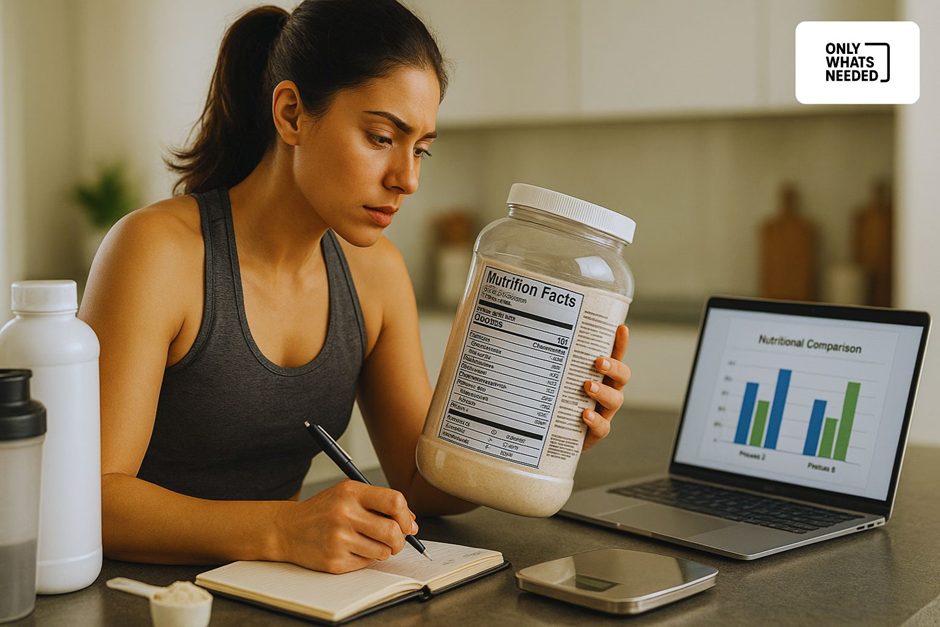
Let’s be real — walking into a supplement store today feels like stepping into a jungle. Dozens of whey protein tubs, all shouting at you with bold fonts: 24g Protein! Zero Sugar! Hydrolyzed Isolate!
But once you flip the tub and try to read the whey protein label? Suddenly it’s all small print, chemical terms, and things you didn’t expect in a “healthy” product.
That’s exactly why learning how to read a protein label like a pro is more important than ever.
This guide will break it all down for you — from identifying real protein sources to dodging shady ingredients. And to top it off, we’ll show you how brands like Only Whats Needed (OWN) are setting a new benchmark of transparency and simplicity in the whey protein game.
Let’s decode the label together — because your gains deserve better.
📦 1. Start with the Protein Type — Not All Whey Is Equal
The protein source is the most important part of the label. Look for:
- Whey Protein Isolate (WPI) – 90%+ protein, low in carbs/fat, lactose-free
- Whey Protein Concentrate (WPC) – 70–80% protein, cheaper, may have more lactose
- Whey Protein Hydrolysate – Pre-digested for faster absorption, usually pricier
💡 Pro tip: If WPI is the first ingredient on the label, that’s a good sign you’re getting quality.
🧮 2. Protein Per Serving vs Scoop Size
This is one of the biggest tricks in the book.
Let’s say a label shows:
- Scoop Size: 40g
- Protein Per Serving: 22g
So what’s the other 18g? 🤔 That’s where they sneak in flavors, thickeners, and other fillers.
✅ A high-quality whey should offer 75–90% protein per scoop. Anything less = you’re paying for fluff.
🧾 3. Ingredient List: Short, Simple, Understandable
The supplement label guide rule is: If you can’t pronounce it, question it.
Bad signs:
- Sucralose, Acesulfame K (artificial sweeteners)
- Xanthan gum, maltodextrin, or cellulose (thickeners/fillers)
- “Proprietary blends” (code for: we’re hiding ingredient amounts)
What you WANT to see:
- Whey protein isolate (first)
- Natural sweeteners (stevia, monk fruit)
- Digestive enzymes (optional but helpful)
This is exactly where clean whey protein stands out — minimal ingredients, zero nonsense, and complete label transparency. No weird stuff.
💡 4. Watch for Hidden Sugars and Artificial Sweeteners
Even if it says “zero sugar”, your protein could still contain:
- Sucralose
- Aspartame
- Maltodextrin (technically a carb, but spikes blood sugar)
These sweeteners are cheap and help brands cut costs — but they can mess with your gut, appetite, and overall health.
Some “sugar-free” proteins still taste overly sweet because they’re packed with artificial flavors and sugar alcohols (like sorbitol or erythritol) — which many people find hard to digest.
✅ What to check on protein label: Look for natural sweeteners or go unflavored if you’re strict about what goes into your body.
🔬 5. Amino Spiking — The Sneaky Protein Inflation Trick
This is one most people miss.
Some brands “inflate” their protein numbers by adding free-form amino acids like:
- Glycine
- Taurine
- Arginine
While these are technically amino acids, they don’t count as complete protein. They’re cheap and misleading. If your whey tub is packed with these early in the ingredient list, you’re probably being duped.
OWN doesn’t play these games. Their formulas are based on real whey, not fluff.
🌱 6. Check for Transparency & Testing
Always look for:
- ✅ Third-party testing (lab results, not just claims)
- ✅ Certifications: non-GMO, gluten-free, etc.
- ✅ No proprietary blends
OWN leads in this category. Every tub tells you exactly what you’re getting — no guessing, no marketing tricks. That’s the value of only whahttps://fitnutraco.com/t’s needed.
📊 7. Check the Nutrition Panel Details
Let’s look beyond just protein grams. A smart label reader also checks:
| Nutrient | Ideal Range (per scoop) |
| Total Calories | 100–130 kcal |
| Total Carbs | Under 3g |
| Sugar | 0g or <1g |
| Sodium | Under 150mg |
| Fat | Under 2g |
This ensures you’re getting lean protein and not turning your shake into a sneaky dessert.
🔄 8. Digestibility: Does It Sit Well With You?
If whey gives you bloating, gas, or stomach cramps, it might be due to:
- Lactose in whey concentrate
- Artificial sweeteners
- Low-quality ingredients
Look for:
- Whey isolate (low or no lactose)
- Added enzymes like lactase
- Clean formulas without gums or fillers
OWN uses isolate + minimal ingredients — ideal for easy digestion and performance-focused users.
⚠️ 9. Red Flags to Watch Out For
Avoid whey protein labels that:
- Hide behind “proprietary blend”
- Have long ingredient lists with scientific-sounding additives
- Show high scoop weight but low actual protein
- Don’t share lab testing or third-party certifications
Just because a label looks clean, doesn’t mean it is.
🏁 Final Thoughts: Labels Don’t Lie — But Brands Can
In the world of supplements, knowledge is your best defense.
Once you know how to read a whey protein label, you’ll never get fooled by marketing again. You’ll make better decisions, avoid junk, and choose brands that genuinely care about what you put into your body.
That’s where Only Whats Needed comes in — they’ve built their entire brand around purity, honesty, and simplicity. No tricks. No fluff. Just clean protein the way it should be.
Whether you’re bulking, cutting, or simply staying healthy — your whey protein shouldn’t be a guessing game.
It should be a tool for progress.